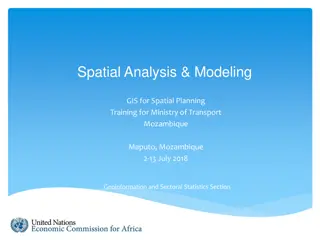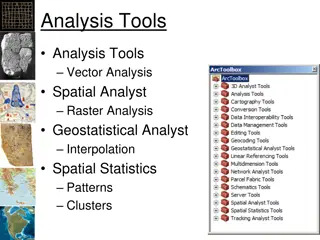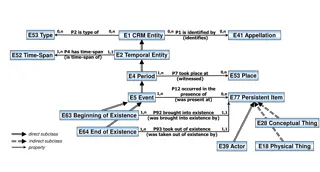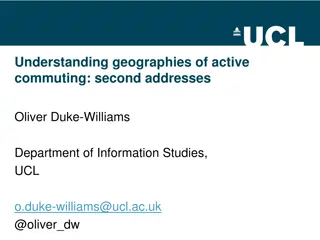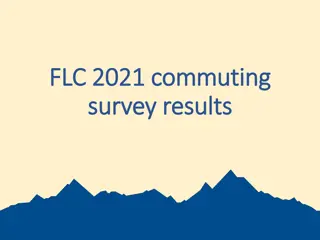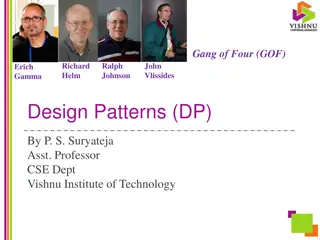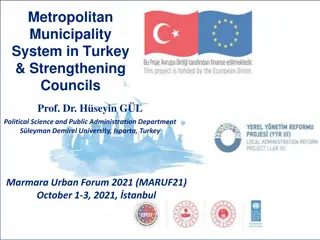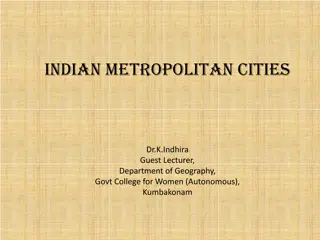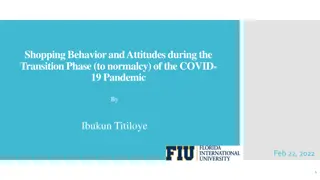Spatial Behavior Patterns in Moscow Metropolitan Area: Commuting & Shopping Trends
This study explores the changes in spatial behavior patterns among commuters in the Moscow Metropolitan Area, focusing on commuting habits, residential developments, and the impact on traffic flow. It analyzes the shift in behaviors based on distance from Moscow and the influence of economic factors on travel patterns.
Download Presentation

Please find below an Image/Link to download the presentation.
The content on the website is provided AS IS for your information and personal use only. It may not be sold, licensed, or shared on other websites without obtaining consent from the author.If you encounter any issues during the download, it is possible that the publisher has removed the file from their server.
You are allowed to download the files provided on this website for personal or commercial use, subject to the condition that they are used lawfully. All files are the property of their respective owners.
The content on the website is provided AS IS for your information and personal use only. It may not be sold, licensed, or shared on other websites without obtaining consent from the author.
E N D
Presentation Transcript
Changes of Spatial Behavior Patterns in Moscow Metropolitan Area Commuting Daching Shopping
More than 5k people in Moscow and Moscow region in 2014 were asked about their spatial behavior (same in 2016) Field works at bus stations in Moscow SURVEYS M SOURCES OF D A A J O R Central PPK (major railway carrier in the region) IEC s Suburban Real Estate database STATISTICS T A Data from mobile phones on traffic between Moscow and selected territories of Moscow region BIG DATA
CHANGES IN COMMUTERS SPATIAL BEHAVIOR ARE WEAK AND DEPEND ON DISTANCE TO MOSCOW Commuters from Moscow region who works/studies in Moscow (travel to Moscow 3 times a week and more often) % of 18+ pop. in 2016 People, 2016 2016/14 Drivers 16,8% Moscow region, total 1 012 749 +1,4% First belt (< 30 km from Moscow ring road) Residential development continues, families from Moscow seek for the cheaper homes 26,4% 508 889 +3,1% Created jobs redirect commuting (Domodedovo, Solnechnogorsk, etc..) 14,5% Middle belt (30-60 km) 400 691 -0,8% Distant second houses suitable for living during the whole year emerges (Ruza, Mozhaysk); Recession of some local economies 7,4% Far belt (> 60 km) 103 170 +2,6% Source: IEC sociologic researches
NUMBER OF PEOPLE WHO LIVES IN MOSCOW REGION AND TRAVELS TO MOSCOW NOT REGULARY REDUCED DRAMMATICALLY People, 2016 % of 18+ pop. in 2016 2016/14 Drivers More students from Moscow region studies in Moscow due to reduction of small universities branches People who goes to Moscow for business occasionally 3,8% 233 280 +25,5% People who goes to Moscow for other purposes occasionally, including 43,4% 2 602 595 -21,7% Real income decrease and transport tariffs growth Modern shopping molls emerged in the largest cities of Moscow region (Mytishi, Podolsk, Balashikha, etc.) Lower-income groups made a major contribution to the traffic drop. 13,5% leisure 819 548 -23,5% 5,6% shopping 337 641 -64,1% People who have not visited Moscow during the year, including 31,8% 1 933 765 +65,0% Moscow region government has abolished subsidies for elderly people s journeys by Moscow public transport elderly (retired) people 635 380 10,8% +31,0% Source: IEC sociologic researches
MORE OFFICES TO MOVE TO OUTSKIRTS AND LESS PEOPLE TO VISIT MOSCOW REGION People who dwells in Moscow permanently People, 2016 % of 18+ pop. in 2016 2016/14 Drivers Commuters from Moscow who works/studies in Moscow region (travel 3 times a week and more often) Migration of offices to suburbs accelerates and gradually equalizes inbound and outbound traffic to Moscow at peak hours. Speed trains and highways are preferable 2,9% 427 713 +50,1% Continuing dacha and cottage development especially at the middle belt of Moscow region (the highest demand for land plots without buildings) Owners of dacha or cottage in Moscow region 34,5% 3 501 276 +3,3% Travelers to Moscow region with other purposes and doesn t have dacha Income decrease and transport tariffs growth. Lower-income groups made a major contribution to the traffic drop. 33,5% 3 342 127 -9,0% People who have not visited Moscow region during the year 27,3% 2 959 175 +10,4% Source: IEC sociologic researches
1351mln JOURNEYS BETWEEN MOSCOW AND the REGION in 2016 WHICH IS 98,2% to 2014 Modal split of journeys between Moscow and the Region Number of journeys, by types of spatial behavior Suburban trains Speed trains Bus Car Other Commuters 432 100% 80% Other purposes 219 32.4% 38.5% 57.2% 65.7% 60% 20.8% "Dacha" owners 339 22.9% 40% 18.7% 9.8% 20% 39.7% 29.9% Other purposes 362 24.0% 23.2% 0% Commuters Other purposes "Dacha" owners Other purposes 0 100 200 300 400 500 MLN. JOURNEYS Source: IEC analysis Source: IEC analysis
PATTERNS OF MOBILITY BETWEEN MOSCOW AND THE REGION DURING THE YEAR, THE WEEK and THE DAY Seasonal trends in traffic between Moscow and the Region (example of Noginsk and Orekhovo-Zuevo) Tuesday-Thursday average traffic during the day (example of Noginsk) To Moscow To Noginsk 2,85*X 130% 120% 110% 100% 90% 1,66*X 80% 70% 9:00 10:00 11:00 12:00 13:00 14:00 15:00 16:00 17:00 18:00 19:00 20:00 21:00 22:00 23:00 0:00 1:00 2:00 3:00 4:00 5:00 6:00 7:00 8:00 60% Saturday average traffic Moscow - Noginsk Moscow - Orekhovo-Zuevo To Moscow To Noginsk 110.0% 60.0% Mon Tue Wed Thu Moscow-Noginsk Fri Sat Sun 10:00 23:00 0:00 Source: IEC analysis on Beeline data 1:00 2:00 3:00 4:00 5:00 6:00 7:00 8:00 9:00 11:00 12:00 13:00 14:00 15:00 16:00 17:00 18:00 19:00 20:00 21:00 22:00 Moscow - Orekhovo-Zuevo
POLICY TO BALANCE MOBILITY AND LIFE Targeting peaks flexible working hours and work from home flexible tariff policy Reduce commuting preferences for offices in Moscow Region inhibiting of house construction in the first belt Switch to public transport HSR development LRT development
Please, dont hesitate to contact me Pavel Chistyakov pachistyakov@infraeconomy.com +79164615151






